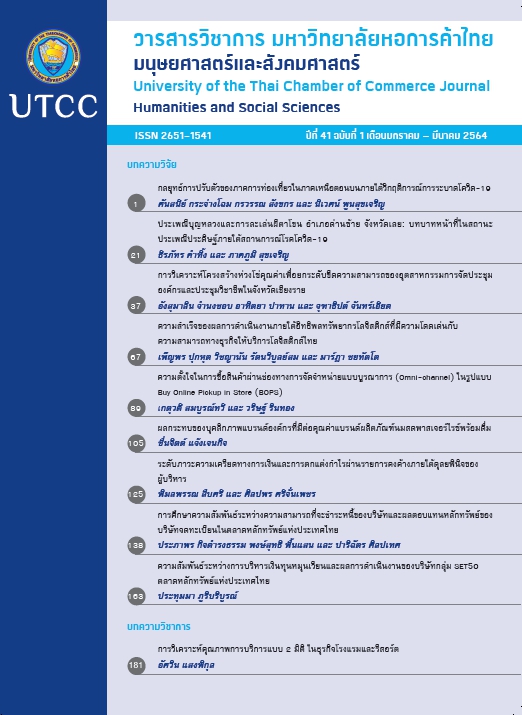The Adaptation Strategy of Tourism in Upper North of Thailand under the COVID-19 Pandemic
Main Article Content
Abstract
This research aimed to: 1) analyze the data on strengths, weaknesses, opportunities, and threats of tourism in the upper northern region under the crisis of the outbreak of Covid-19 and 2) suggest adaptation strategies of the tourism in the upper northern region under the outbreak of Covid-19 through the TOWS Matrix process. The structured interview form is used for in-depth interviews with people involved in tourism. SWOT analysis used in data analysis that can be further developed in the adaptation strategy of the tourism sector under the outbreak of Covid-19 through the TOWS Matrix. The research found that strategies that should be proactively implemented include promoting tourism on cultural and natural strengths, and proactive tourism marketing. Strategies that can improve and resolve weaknesses from opportunities include using information technology to develop tourism innovations, Developing the potential of entrepreneurs and tourism staffs, and encouraging people in the community to participate and benefit from tourism. Preventive strategies include building confidence for tourists, and communicate the northern tourism image that is still a quality and safe tourist attraction. Strategies that should eliminate weaknesses and avoid limitations include development of new normal tourism in the upper north of Thailand, Sustainable linking tourism development, and creating a network of tourism cooperation from all sectors.
Article Details

This work is licensed under a Creative Commons Attribution-NonCommercial-NoDerivatives 4.0 International License.
ลิขสิทธิ์ของบทความ
ผลงานที่ได้รับการตีพิมพ์ถือเป็นลิขสิทธิ์ของมหาวิทยาลัยหอการค้าไทย ห้ามมิให้นำเนื้อหา ทัศนะ หรือข้อคิดเห็นใด ๆ ของผลงานไปทำซ้ำ ดัดแปลง หรือเผยแพร่ ไม่ว่าทั้งหมดหรือบางส่วนโดยไม่ได้รับอนุญาตเป็นลายลักษณ์อักษรจากมหาวิทยาลัยหอการค้าไทยก่อน
References
กรมสุขภาพจิต. (2563). New normal ชีวิตวิถีใหม่. สืบค้นเมื่อ 23 มิถุนายน 2563, จาก https://www.dmh.go.th/news/view.asp?id=2288
กรวรรณ สังขกร, อาชว์บารมี มณีตระกูลทอง, ศันสนีย์ กระจ่างโฉม, สรณะ สมโน, ไพรัช พิบูลย์รุ่งโรจน์ และอารยะ ลายประวัติ. (2559). การศึกษาเพื่อการพัฒนาศักยภาพการแข่งขันทางการตลาดการท่องเที่ยวเชิงวัฒนธรรมในเส้นทางอารยธรรมล้านนา (ภายใต้แผนงาน “การบริหารจัดการและการพัฒนาการท่องเที่ยวเชิงวัฒนธรรมเส้นทางอารยธรรมล้านนาเชื่อมโยงกับ สปป.ลาว สหภาพเมียนม่าร์ และสาธารณรัฐประชาชนจีน (ตอนใต้)). เชียงใหม่: สถาบันวิจัยสังคม มหาวิทยาลัยเชียงใหม่.
กระทรวงการท่องเที่ยวและกีฬา. (2558). คู่มือการจัดทำแผนปฏิบัติการพัฒนาการท่องเที่ยวภายในเขตเขตพัฒนาการท่องเที่ยว พ.ศ. 2559-2563. กรุงเทพฯ: สำนักงานปลัดกระทรวงการท่องเที่ยวและกีฬา.
กระทรวงการท่องเที่ยวและกีฬา. (2563). สถานการณ์การท่องเที่ยวในประเทศ รายจังหวัด ปี 2563. สืบค้นเมื่อ 8 กรกฎาคม 2563, จาก https://www.mots.go.th/more_news_new.php?cid=592
กระทรวงอุดมศึกษา วิทยาศาสตร์ วิจัย และนวัตกรรม. (2563). New normal ชีวิตวิถีใหม่ และการปรับตัวในภาวะ COVID-19. สืบค้นเมื่อ 23 มิถุนายน 2563, จาก https://www.mhesi.go.th/home/index.php/pr/all-media/55-covid-19/covid-km/1448-new-normal
การท่องเที่ยวแห่งประเทศไทย. (2556). ทรัพยากรการท่องเที่ยวไทย ชุดภาคเหนือ ภูมินิเวศ โบราณคดีและประวัติศาสตร์ กลุ่มชาติพันธุ์และชุมชน ศิลปวัฒนธรรม. กรุงเทพฯ: บริษัท วิเสจ จำกัด.
คมปทิต สกุลหวง. (2561, 15 กันยายน). ครบรอบ 10 ปีวิกฤตแฮมเบอร์เกอร์ (ซับไพรม์) โลกควรเรียนรู้อะไร. สำนักข่าว The Standard. สืบค้นจาก https://thestandard.co/hamburger-crisis-10-years-on/
ชาตรี ปรีดาอนันทสุข. (2559). เปลี่ยนมุมมองของการจัดการวิกฤตด้วยแนวคิดการจัดการวิกฤตเชิงบูรณาการ. Journal of Business, Economics and Communications, 8(1), 27-38. สืบค้นจาก https://so02.tci-thaijo.org/index.php/BECJournal/article/view/54850/45522
ณัฏฐพันธ์ เขจรนันทน์. (2552). การจัดการเชิงกลยุทธ์. กรุงเทพฯ: ซีเอ็ดยูเคชั่น.
ธานินทร์ ศิลป์จารุ. (2553). การวิจัยและวิเคราะห์ข้อมูลทางสถิติด้วย SPSS (พิมพ์ครั้งที่ 11). กรุงเทพฯ: เอส อาร์ พริ้นติ้ง แมสโปรดักส์.
เนตร์พัณณา ยาวิราช. (2548). การจัดการสมัยใหม่: Modern Management (พิมพ์ครั้งที่ 4). กรุงเทพฯ: โรงพิมพ์ บริษัทเซ็นทรัล เอ็กเพรส.
แนวทางฟื้นฟู “การท่องเที่ยว” หลังวิกฤติโควิด-19. (2563, 16 มิถุนายน). กรุงเทพธุรกิจ. สืบค้นจาก
https://www.bangkokbiznews.com/news/detail/885171
มหาวิทยาลัยศรีปทุม. (2563). โอกาสการท่องเที่ยวประเทศไทยหลังโควิด หรือเราควรเป็น Medical Health Tourism Hub ของภูมิภาค. สืบค้นเมื่อ 23 มิถุนายน 2563, จาก https://www.spu.ac.th/activities/26186
ศันสนีย์ กระจ่างโฉม, อาชว์บารมี มณีตระกูลทอง, และเผชิญวาส ศรีชัย. (2562). แนวทางการพัฒนากิจกรรมการท่องเที่ยวสำหรับนักท่องเที่ยวผู้สูงอายุชาวต่างชาติในพื้นที่อารยธรรมล้านนา. วารสารวิชาการ มหาวิทยาลัยหอการค้าไทย มนุษยศาสตร์และสังคมศาสตร์, 39(3), 75-90.
เศกสิน ศรีวัฒนานุกูลกิจ. (2553). การจัดการสาธารณภัย. เชียงใหม่: มหาวิทยาลัยเชียงใหม่, คณะสังคมศาสตร์.
สมยศ นาวีการ. (2545). แนวความคิด: การบริหารเชิงกลยุทธ์. กรุงเทพฯ: บรรณกิจ.
Amadeus. (2015). Future traveler tribes 2030: Understanding tomorrow's traveller. Retrieved from https://amadeus.com/documents/en/retail-travel-agencies/research-report/amadeus-future-traveller-tribes-2030-report.pdf
Blain, C., Levy, S. E., & Ritchie, J. B. (2005). Destination branding: Insights and practices from destination management organizations. Journal of Travel Research, 43(4), 328-338.
Bruce, H. (1989, November-December). The origin of strategy. Harvard Business Review. Retrieved from https://hbr.org/1989/11/the-origin-of-strategy
Bundy, J., Pfarrer, M. D., Short, C. E., & Coombs, W. T. (2017). Crises and crisis management: Integration, interpretation, and research development. Journal of Management, 43(6), 1661–1692. doi:10.1177/0149206316680030
Burkle, F. M. Jr. (2006). Globalization and disasters: Issues of public health, state capacity and political action. Journal of International Affairs, 59(2), 231–265.
CLOSM. (2017). Tourism human resource management challenges, trends and opportunities. Retrieved June 5, 2020, from https://cedec.ca/wp-content/uploads/2014/10/Dossier_RH_Closm_31_mars2017_en_FINAL.pdf
Gossling, S. (2002). Global environmental consequences of tourism. Global Environmental Change, 12(4), 283–302. https://doi.org/10.1016/S0959-3780(02)00044-4
Gossling, S., Scottd, D., & Hallf, C. M. (2020). Pandemics, tourism and global change: a rapid assessment of COVID-19. Journal of Sustainable Tourism. Retrieved April 27, 2020, from https://www.tandfonline.com/doi/full/10.1080/09669582.2020.1758708
Hall, C. M. (2020). Biological invasion, biosecurity, tourism, and globalisation. In D. Timothy (Ed.), Handbook of globalisation and tourism (pp. 114–125). Northampton, MA: Edward Elgar.
Kenneth, A. (1971). The concept of corporate strategy. Home-wood, IL: Richard D. Irwin.
Kim, S.-H., Han, H.-S., Holland, S., & Byon, K. K. (2009). Structural relationships among involvement, destination brand equity, satisfaction and destination visit intentions: The case of Japanese outbound travelers. Journal of Vacation Marketing, 15(4), 349-365.
Kontogeorgopoulos, N., & Chulikavit, K. (2010). Supply-side perspectives on ecotourism in Northern Thailand. International Journal of Tourism Research, 12(5), 627-641. Retrieved from https://onlinelibrary.wiley.com/doi/epdf/10.1002/jtr.785
Kyle, G., & Chick, G. (2007). The social construction of a sense of place. Leisure Sciences, 29(3), 209-225.
Leslie, W. R., & Lloyed, L. B. (1995). Management: Skills and application (7th ed). Chicago, IL: Van Hoffmann.
Porter, M. E. (1980). Competitive strategy. New York, NY: Free Press.
Qu, H., Kim, L. H., & Im, H. H. (2011). A model of destination branding: Integrating the concepts of the branding and destination image. Tourism Management, 32(3), 465-476.
Richards, G. (1995). Cultural tourism in Europe. Wallingford, UK: CAB International.
Trupp, A. (2014). Ethnic tourism in Northern Thailand: Viewpoints of the Akha and the Karen. In K. Husa, A. Trupp, & H. Wohlschlägl (Eds.), Southeast Asian mobility transitions, issues and trends in tourism and migration (pp. 346–376). Vienna: Department of Geography and Regional research, University of Vienna.


